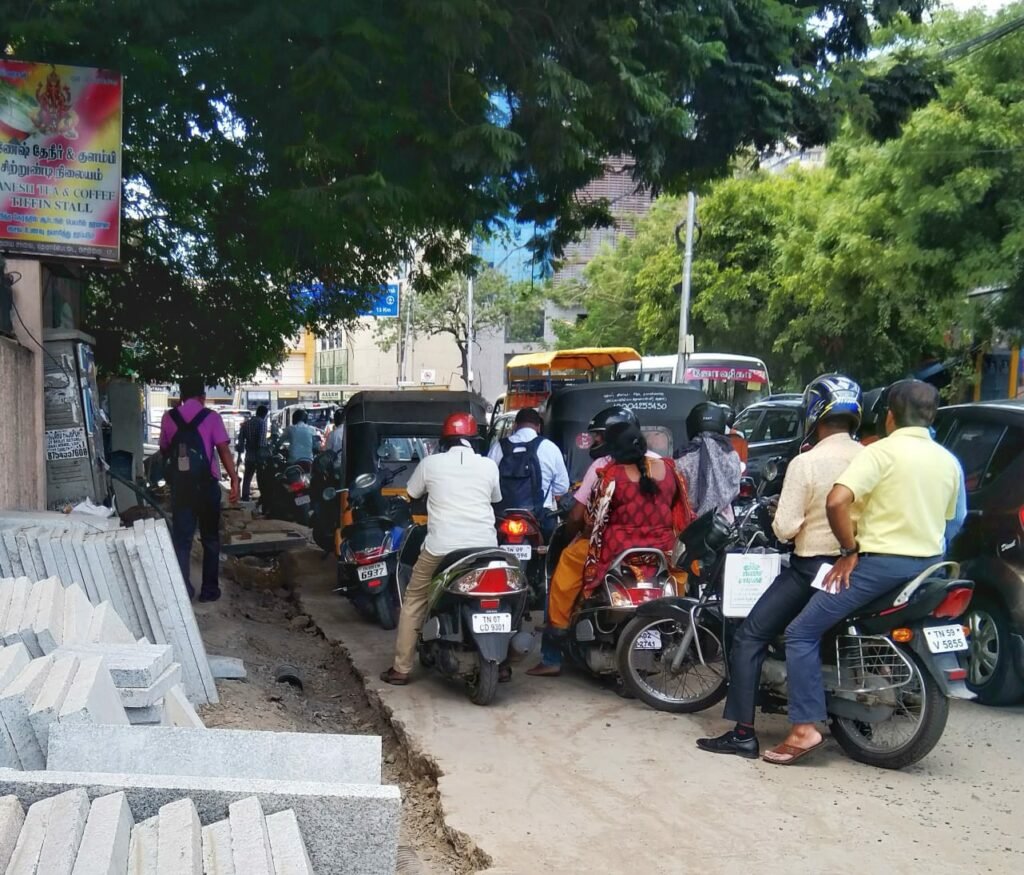Read in : தமிழ்
The road to Chief Minister M K Stalin’s Singara Chennai is technically now open, with the DMK winning 153 wards in the Greater Chennai Corporation Council and its ally Congress 13 wards vs. the AIADMK’s 15 and the rest being a sprinkling of others, including ruling party allies and one opposition BJP Councillor. It may be time for the DMK leadership in Chennai to commit to their leader’s vision of Singara Chennai.
Flush with a series of poll victories, the DMK, a party that comfortably leverages the din and bustle of urban Tamil Nadu, must feel chuffed that the coast is clear to remove the debris from ten years of haphazard urban development in Chennai and major cities.
Some of the smart city projects in the capital, such as a major overhead pedestrian footpath in T Nagar lie incomplete, visually polluting the landscape. The solid waste management system has failed to deliver sustainably.
The election euphoria is over and the State government, as well as the new Chennai Corporation Council, have to consider a world that has changed a lot in ten years.
- Cities are at the forefront of fighting carbon emissions today and future plans must align with climate change objectives.
- There is a new law on rights of the disabled, and infrastructure must be shaped to meet its provisions. This will help everyone, since universal design and disabled-friendly infrastructure help everyone.
- The car and two-wheeler population in Chennai has exploded over the years, touching 9.6 lakh and 47.56 lakh respectively in 2020. This means challenge and opportunity in creating parking infrastructure, beyond just roads.
- The city has one of the poorest ratios of parks to population. More spaces must be turned into wooded parkland and urban wetlands.
- And, as 2021 made it clear to millions here, extreme weather events, such as 20 cm rain in a few hours on more than one day. The average Chennaiite will want storm management to keep his feet dry in the future.
Chennai and Climate Change
UN Habitat says cities are the biggest consumers of energy with their density of population and economic activity – globally, that makes up 78% of the world’s energy consumed and 60% of greenhouse gas emissions.
As 2021 made it clear to millions here, extreme weather events, such as 20 cm rain in a few hours on more than one day. The average Chennaiite will want storm management to keep his feet dry in the future.
Chennai would have to align its future planning with the goal of cutting carbon emissions, which means expanding rooftop solar energy, building environment-friendly buildings through an updated, strict building code, creating more wetlands to hold water for long periods, regulate urban temperature and act as flood storage. State government buildings are prime targets for full retrofitting, and using their grounds as woodland and wetlands.
On the road to Singara Chennai, the city also has to make its public transport more appealing to cut the use of personal vehicles, thereby slashing carbon emissions. Greater impetus to electric vehicles will produce a bonus effect: cut not just emissions, but particulate pollution in the air. While the Metro Rail will expand in the next two or three years, the bus system has to keep pace by connecting interior areas of residential suburbs and these rail stations.
Disability and urban design
The Councillors of the new Chennai Corporation and the Mayor can make Chennai a model, if they swear by the provisions of the Rights of Persons with Disabilities Act, 2016. Accessibility is a key aspect of this law, which is ignored by government departments, public and private sector institutions in practice.
Public places, bus stops, railway stations and airports, as well as modes of transport such as buses, are covered under accessibility definitions, and so are public buildings. Yet, these do not find a place in day-to-day decisions and implementation. In fact, any rebuilding of infrastructure must conform to these provisions, but there is a severe disconnect between policy and implementation. Most roads in Chennai lack functional footpaths (pavements) that meet engineering norms and universal design principles and road margins remain dead space. This has to be pursued in mission mode.
The original law had laid down two years for compliance from the publication of rules on June 15, 2017, but that deadline is long gone. So the ball is now with the new Council and the Metropolitan Planning Committee of Chennai. Singara Chennai has to be disabled-friendly.
Pay to park, reap the revenue
Even with a robust public transport system, the use of private vehicles such as cars and two-wheelers is bound to grow due to affluence and personal preferences. This calls for a relook at existing parking policies, which currently subsidise private users who occupy public space.
By allocating spaces for paid parking, and adopting policies that allow private provision of paid parking infrastructure, the car user gets a safe place to keep the vehicle and the government can harvest revenue. It is a policy fallacy, to view car parking as a matter of right. Nowhere in the world is this possible. In a city such as Bogota, Colombia, the enlightened Mayor Enrique Penelosa ensured that specified parking grounds were provided, to eliminate street parking. ‘Pay to park’ is the way to go in Chennai, with a rate that is pegged to the level of congestion in that area. It can help the city find new revenue.

Chennai needs usable pavements and better traffic management
Going to Ratna Cafe in Triplicane or Mylapore South Mada Street, or the north Indian hotels in George Town would be a breeze, if there was parking nearby! In Singara Chennai, we will drive up to Triplicane assured that parking will be nearby.
Missing the trees and the parks
Chennai Corporation says it has 525 public parks and 128 traffic islands besides road median dividers that serve as green spaces. Calling these spaces parks is a misnomer, because most of them are just slivers of land with a few trees.
The only real parks in the city are the Theosophical Society gardens and the Guindy National Park, while some like Panagal Park, Natesan and Jeeva Parks, the Chetpet, Adyar and Semmozhi Poonga eco-parks are weak substitutes for a Lalbagh or Cubbon in Bengaluru.
There is a serious difference of opinion among naturalists on Miyawaki forests sought to be created in small land parcels, since these do not adopt an ecosystem approach and merely produce dense greenery through engineering.
Chennai Corporation says it has 525 public parks and 128 traffic islands besides road median dividers that serve as green spaces. Calling these spaces parks is a misnomer, because most of them are just slivers of land with a few trees.
This time, the effort has to be to scout for sizable land in the urban jurisdiction that can be turned into genuine parks, and not merely Open Space Reservation lands of buildings that are walled gardens with no public access.
Prepare for waterworld
The 2021 floods of November and December show that Chennai needs a large number of wetlands right within the city to store runoff. This may require a New Deal philosophy that leads to the acquisition of built urban areas and their conversion into water bodies to absorb flood waters. The Dutch model of canals may have a place in the city, to carry water to eastern marshland in Pallikaranai, and elsewhere, en route to the sea.
This strategy has implications for climate change adaptation, since large wetlands can moderate the effects of summers and reduce heat islands.
The Constitution, through Article 243W and Twelfth Schedule provides the elected Councillors, the Mayors and the State government the opportunity to shape the destiny of all cities by formulating good policies on urban planning, parks and gardens, roads, public amenities including bus stops and parking lots, and broadly on poverty alleviation. Most of these areas have a direct bearing on the larger goal of pollution reduction and climate change mitigation and adaptation. Without an efficient flood mitigation system, we can never aspire to be Singara Chennai.
This is the moment for Stalin and his soon-to-be-elected Mayor to seize, to place Chennai firmly on the path of sustainable development. There are other big imperatives, such as solid waste management and plastics reduction, but they need a separate discussion.
Read in : தமிழ்











